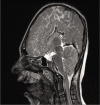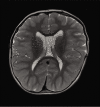Apert syndrome: Cranial procedures and brain malformations in a series of patients
- PMID: 33194294
- PMCID: PMC7655990
- DOI: 10.25259/SNI_413_2020
Apert syndrome: Cranial procedures and brain malformations in a series of patients
Abstract
Background: Apert syndrome is one of the most severe craniofacial disorders. This study aims to describe the craniofacial surgeries and central nervous system malformations of a cohort of children with Apert syndrome treated in the past 20 years and to compare these data with previously published data.
Methods: Retrospective analysis of a series of patients with Apert syndrome treated between 1999 and 2019 in our hospital. Information was analyzed regarding craniofacial procedures, hydrocephalus and presence of shunts, Chiari malformation Type 1, and other brain malformations such as corpus callosum and septum pellucidum anomalies.
Results: Thirty-seven patients were studied. Ventriculoperitoneal shunt prevalence was 24.3%, and 8.1% of patients required decompressive surgery for Chiari malformation. All of them needed at least one cranial vault remodeling procedure. The median age for this procedure was 8 months. In 69.7% of patients, the first cranial vault intervention was performed in the fronto-orbital region. In 36.4% of patients, a midface advancement had been performed at the time of this review, although this proportion was very dependent on the follow-up period and the age of the patients. The median age for the midface advancement procedure was 5.25 years. Anomalies of the corpus callosum and the septum pellucidum were reported in 43.2% and 59.5% of patients, respectively.
Conclusion: Apert syndrome is a type of syndromic craniosynostosis, and patients usually require one or more cranial and facial surgeries. In comparison with other syndromic craniosynostosis types, Apert syndrome less frequently requires a VP shunt or treatment for a Chiari malformation.
Keywords: Apert syndrome; Craniosynostosis; Fronto-orbital advancement; Hydrocephalus; Monobloc advancement.
Copyright: © 2020 Surgical Neurology International.
Conflict of interest statement
There are no conflicts of interest.
Figures




Similar articles
-
Apert syndrome: Surgical outcomes and perspectives.J Craniomaxillofac Surg. 2016 Sep;44(9):1238-45. doi: 10.1016/j.jcms.2016.06.001. Epub 2016 Jun 9. J Craniomaxillofac Surg. 2016. PMID: 27378001
-
Management of ventriculomegaly in pediatric patients with syndromic craniosynostosis: a single center experience.Acta Neurochir (Wien). 2021 Nov;163(11):3083-3091. doi: 10.1007/s00701-021-04980-3. Epub 2021 Sep 27. Acta Neurochir (Wien). 2021. PMID: 34570275
-
Twenty-year experience with early surgery for craniosynostosis: II. The craniofacial synostosis syndromes and pansynostosis--results and unsolved problems.Plast Reconstr Surg. 1995 Aug;96(2):284-95; discussion 296-8. Plast Reconstr Surg. 1995. PMID: 7624401
-
Apert syndrome: neurosurgical outcomes and complications following posterior vault distraction osteogenesis.Childs Nerv Syst. 2024 Aug;40(8):2557-2563. doi: 10.1007/s00381-024-06436-2. Epub 2024 May 3. Childs Nerv Syst. 2024. PMID: 38700706
-
Apert Syndrome: Selection Rationale for Midface Advancement Technique.Adv Tech Stand Neurosurg. 2023;46:245-266. doi: 10.1007/978-3-031-28202-7_13. Adv Tech Stand Neurosurg. 2023. PMID: 37318579 Review.
Cited by
-
Syndromic Hydrocephalus.Neurosurg Clin N Am. 2022 Jan;33(1):67-79. doi: 10.1016/j.nec.2021.09.006. Neurosurg Clin N Am. 2022. PMID: 34801143 Free PMC article. Review.
References
-
- Allam KA, Wan DC, Khwanngern K, Kawamoto HK, Tanna N, Perry A, et al. Treatment of apert syndrome: A long-term follow-up study. Plast Reconstr Surg. 2011;127:1601–11. - PubMed
-
- Anderson PJ, Netherway DJ, Abbott AH, Cox T, Roscioli T, David DJ. Analysis of intracranial volume in apert syndrome genotypes. Pediatr Neurosurg. 2004;40:161–4. - PubMed
-
- Breik O, Mahindu A, Moore MH, Molloy CJ, Santoreneos S, David DJ. Apert syndrome: Surgical outcomes and perspectives. J Craniomaxillofac Surg. 2016;44:1238–45. - PubMed
-
- Breik O, Mahindu A, Moore MH, Molloy CJ, Santoreneos S, David DJ. Central nervous system and cervical spine abnormalities in apert syndrome. Childs Nerv Syst. 2016;32:833–8. - PubMed
-
- Carrera IA, Martínez-Frías ML, Pérez JJ, Grisolía LP, Rodríguez AC, Conde CN, et al. Apert syndrome: Clinicoepidemiological analysis of a series of consecutive cases in Spain. An Esp Pediatr. 1999;51:667–72. - PubMed
LinkOut - more resources
Full Text Sources
Miscellaneous
